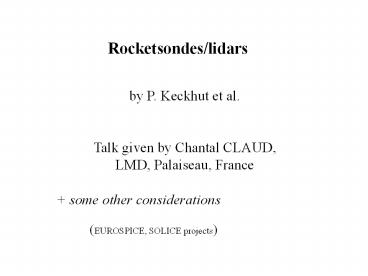Pr - PowerPoint PPT Presentation
Title: Pr
1
Rocketsondes/lidars
by P. Keckhut et al. Talk given by Chantal
CLAUD, LMD, Palaiseau, France
some other considerations
(EUROSPICE, SOLICE projects)
2
This study Temperature trends in the middle
atmosphere of the mid-latitude as seen by
systematic rocket launches above Volgograd
Agnès Kubicki1, Philippe Keckhut1, Marie-Lise
Chanin1, Alain Hauchecorne1,Evgeny Lysenko2,
Georgy Golitsyn2
3
Instrumental changes on US Rocket
4
Instrumental changes on soviet rocket
- Volgograd sensor changes
Corrected data
Raw data
Estimated from the time serie analyses
Kubicki et al., submitted toJASTP, 2004.
Estimated from the aerothermic calculations
5
Tidal interferences
6K
Keckhut et al., J. Geophys. Res., p10299, 1996
They induce large interferences in data
comparisons, trends and satellite validations
Keckhut et al., J. Geophys. Res., p447, 1999
6
Tidal interferences
- Volgograd
1500
1000
200
Averaged temperature 45-55 km
Time of launch
Kubicki et al., submitted toJASTP , 2004.
7
Temperature trends
- Significant trends
- 1-3 K/decade
- Homogeneous from 8s to 44N
Rockets 8S-34N
Keckhut et al., J. Geophys. Res., p447, 1999
Lidar OHP 44N
Beig et al, Rev. Geoph., 2003
8
Trends as a function of latitude
Wallops, ---
Wallops
OHP
US tropical
OHP, _ _
US tropical
Volgograd
Volgograd
Summer
Riory
Winter
Riory, .
US tropical 8S-34N Wallops Island
37,5N Ryori, Japan 39N OHP, France
44N Volgograd 49N
Kubicki et al., submitted toJASTP, 2004.
9
Les données
Les trois bases de données considérées au meme
temps offrent une description détaillée de la
stratosphère au cours de 20 dernières années
10
The multi-parameter regressions
(AMOUNTS)(Hauchecorne et al., 1991 Keckhut et
al., 1995)
- To evaluate temperature trends and variability
(for data and model outputs) - It is necessary to parametrize the variability
- T(t) m St ATrend BSolar CQBO
DENSO EAO Nt - The A, B, C, D, E terms represent the amplitude
of trends / factors of variability - (! Volcanic eruptions)
- The residuals (AR(1)) include all the
variability not considered in the
parametrization. - The analysis of the residual terms
- model inadequacies
- the degree of confidence of the analysis
11
Les facteurs de variabilité de la température
stratosphérique
Solaire
QBO(B. Naujokat)
SOI
Indice AO Thompson and Wallace, 1998
12
Datasets
- US Rocketsondes 1969-90s
- LIDAR in France 1970-2001
- SSU 1979-2001
13
Response to solar changes11-year time scale
US Rocket sites
Tropic Subtropic Midlatitude
14
Response to solar changes11-year time scale
Lidar 44N
Summer Winter
15
Response to solar changes11-year time scale
60
SSU at 6 hPa
16
Response to solar changes
- Photochemical response at low latitude
- Negative response at high latitude
- Strong seasonal response
Role of the dynamics?
17
Mecanistic simulations of the atmospheric solar
response
3D Rose/Reprobus model at SA
- Responses depend on PW activity
- Responses are highly non-linear
Clim1.5
Clim1.8
Clim2.2
18
Conclusions
- Equatorial response close to the photochemical
response (1-2 K) - Negative response at mid and high latitude with a
strong seasonal effect - The solar response is strongly related to wave
activity - Numerical simulations show a similar response
with a specific planetary wave level
19
AO regressions
Vertical structures of annual regressions
Winter
Seasonal regressions at 100 hPa
20
CONTRIBUTION OF THE ARCTIC OSCILLATION TO
OBSERVED TRENDS AT 50 HPA (IN K/DECADE)
FUB 1979-1998
21
Weakening of the mean residual circulation(1980
1999)
Trend in the ?TD-M K/season/year
- Trends of ?TD-M
30 hPa
100 hPa
50 hPa
2 sigma at 100 hPa
22
The UM simulations
- The UM model
- 64 vertical levels ( 1000 hPa - 0.01 hPa)
- Horizontal resolution 2.5 x 3.75
- Non-orographic gravity wave drag scheme (Scaife
et al., 2002) - Methane oxydation scheme as a source for water
vapour - Transient simulations (1980-1999)
- Trend imposed on the WMGHG following the IPCC
IS92a scenario (Houghton et al., 1996) - Sea Ice and SST fields specified with data from
the AMIP (Gates, 1992) - Ensembles
- UM - control ensemble of 5 simulations
including AMIP-II ozone climatology - (seasonal cycle in ozone) -gt representing
conditions prior to ozone depletion - UM - ozone ensemble of 5 simulations including
a linear trend in ozone varying with latitude and
height. Ozone trends are calculated from TOMS
1979-1997, SAGEI/II (Langemtaz, 2000)
23
UM-ozone
UM-control
24
The ozone contribution Changes in the MRC
UM-O3 30 hPa
UM-O3 100 hPa
UM-Contrôle 100 hPa
Tendance de ?TD-M K/saison/année
25
Fz trends (Jan- Feb- March)
UM-ozone
UM-control
Ozone changes responsible for reduction in wave
activity in high latitudes during late winter?
Proposed mechanism (Hu et Tung, 2003)
26
Concerning the future Russian rockets data
continue after 1995, negociations to acquire
them also Lidar data from TMF (Table Mountain
Facility, California) which cover the period
1988-present might be useful. Other lidars data
begin after 1995, so that the record might be
too short. At SA, Agnes Kubicki will work on
Heiss (82N), Molodesnaya (67S), and Thumba
(8N) records. From May 2005 on, Serge Guillas
will work on non-linear methods to determine
trends (bootstrap). At LMD, work will continue on
trend determination (FUB). At SA and LMD, a 20
years run from LMDz-Reprobus is available.































